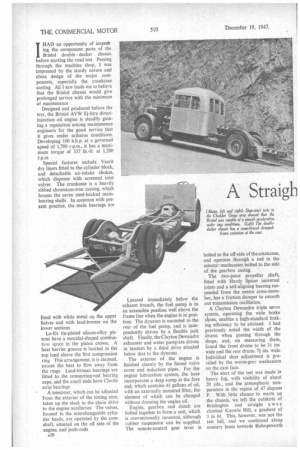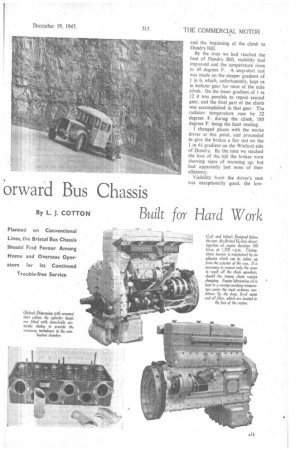Straigh orward Bus Chassis
Page 32

Page 33

Page 34

If you've noticed an error in this article please click here to report it so we can fix it.
By L. J. COTTON Built for Hard Work IHAD an opportunity of inspeoting the component parts of the Bristol double decker chassis before starting the road test. Passing through the machine shop, I was impressed by the sturdy nature and clean design of the major components, especially the crankcase casting All I saw leads me to believe that the Bristol chassis would give prolonged service with the minimum of maintenance
Designed and produced before the war, the Bristol AVW 8f-litre directinjection oil engine is steadily gaining a reputation among maintenance engineers for the good service that it gives under arduous conditions. Developingl 00 b.h.p. at a governed speed of 1,700 r.p.m., it has a maximum torque of 337 lb.-ft. at 1,200 r.p.m • Special features include Vacrit dry liners fitted to the cylinder block, and detachable air-intake chokes, which dispense with screened inlet valves The crankcase is a heavily ribbed chromium-iron casting, which houses the seven steel-backed mainbearing shells. In common with present practice, the main bearings are lined with white metal on the upper halves and with lead-bronze on the lower sections
Lo-Ex tin-plated silicon-alloy pistons have a toroidal-shaped combustion space in the piston crown. A heat barrier groove is located in the top land above the first compression ring This arrangement, it is claimed, causes the heat to flow away from the rings. Lead-bronze bearings are fitted to the connecting-rod bearing caps, and the small ends have Clevite strip bearings
A tensioner, which can be adjusted from the exterior of the timing case, takes up the slack in the chain drive to the engine auxiliaries The valves, housed in the interchangeable cylinder heads, are operated by the camshaft, situated on the off side of the engine, and Push-rods.
130 Located immediately below the exhaust branch, the fuel pump is in. an accessible position well above the frame line when the engine is in position. The dynamo is mounted to the rear of the fuel pump, and is independently driven by a flexible jack shaft. Finally, the Clayton Dewandre exhauster and water pump are driven in tandem by a third drive situated below that to the dynamo.
The exterior of the engine is finished cleanly by the finned valve cover and induction pipes. For the engine lubrication system, the base incorporates a deep sump at the fore end, which contains 41 gallons of oil, with an externally mounted filter, the element of which can be changed without draining the engine oil.
Engine, gearbox and clutch are bolted together to form a unit, which is conventionally mounted, although rubber suspension can be supplied. The remote-control gear lever is bolted to the off-side of the crankcase, and operates through a rod to the selector mechanism bolted to the side of the gearbox casing.
The twci-piece propeller shaft, fitted with Hardy Spicer universal joints and a self-aligning bearing suspended from the centre cross-member, has a friction damper to smooth out transmission oscillation.
A Clayton Dewandre triple servo system, operating the wide brake shoes, enables a high-standard braking efficiency to be attained. I had previously noted the width of the drums when passing through the shops, and, on measuring them, found the front drums to be 31 ins wide and the rear drum; 7i• iris. wide. Individual shoe adjustment is provided by the worm-gear mechanism on the cam face.
The start of the test was made in heavy fog, with visibility of about 20 yds., and the atmospheric temperature in the region of 47 degrees F. With little chance to warm up. the chassis, we left the outskirts of Brislington and straight away climbed Knowle Hill, a gradient of 1 in 61. This, however, was not the test hill, and we continued along country lanes towards Bishopsworth and the beginning of the climb to Dundry Hill.
By the time we had reached the foot of Dundry Hill, visibility had improved and the temperature risen to 49 degrees F. A stop-start test was made on the steeper gradient of 1 in 6, which, unfortunately, kept us in bottom gear for most of the mile climb. On the lesser gradient of 1 in 12 it was possible to regain second gear, and the final part of the climb was accomplished in that gear. The radiator temperature rose by 22 degrees F. during the climb, 180 degrees F. being the final reading.
I changed places with the works driver at this point, and proceeded to give the brakes a fair test on the 1 in 61 gradient on the Winford side of Dundry. By the time we reached the foot of the hill the brakes were showing signs of warming up, but had apparently lost none of their efficiency.
Visibility from the driver's seat was exceptionally good, the low mounted radiator affording every assistance in this connection.
Gear changing was simplified by the constant-mesh third and top ratios, and the steering gear was beyond reproach.
From Winford we continued the journey through Redhill a n d Churchill towards Sidcot. A reasonably level stretch of road provided an opportunity of obtaining the maximum speed, a matter of 35 m.p.h., at which point the governor control came into action. This speed was attained with the axle ratio of 5.4 to 1, but alternative ratios of 6.0 and 6.5 to 1 are provided if required.
At this point we changed over to the measured fuel supply for consumption tests. The first test, representing inter-urban service, was made over, a fairly level route, and a distance of 8.2 miles was covered at an average speed of 25.2 m.p.h. before the half-gallon of fuel was exhausted. This equals 16.4 m.p.g.
The second consumption test, made under town conditions of four stops per mile, was staged with .rapid acceleration and sharp brake appli
cations. The high, back-axle ratio brought the consumption -figure A32
down to 7.8 m.p.g. Normally, for this form of service, I would advocate a lower final-drive ratio. Proving that the engine provided ample power, even with the high ratio, the average speed on the second test worked out to 20.8 m.p.h.
Stopping distances'of 55.4 ft. from 30 m.p.h. and 30 ft. from 20 m.p.h. were attained. These results correspond to efficiencies of 54 and 45 per cent. respectively. The consistency of the braking may be judged by the repeat tests, the results of which did not vary more than 1 ft. even after continual usage of the brakes.
The stretch of road used for braking tests was also employed for the acceleration runs. Again, a variation of merely 3 secs. was recorded in tests conducted in each direction, thus proving that the road was level and that the engine had ample power. From 0 to 20 m.p.h. through the gears was accomplished in 16.6 sees. and 30 m.p.h. in 36.1 secs.
From 10 m.p.h. in top gear, 20 m.p.h. was reached in 18.6 secs. and 30 m.p.h. in 33.2 secs. • In comparison with other tests that I have made, the acceleration results for the Bristol 8i-litre engine, and using a
5.4 to 1 final-drive ratio, appear to be average.
We made our way back to Bristol through Cheddar and the Gorge, stopping on some of the more severe inclines to check the ability of the chassis to start off under the worst conditions. The Bristol clutch appeared to be ideal for such situaations, and there was no judder.
With the daylight fading rapidly and the threat of poor visibility, there was little time lost on the return journey, and the engine, for the major part of the run, was operating at maximum governed speed. Because of this high-speed run I-had expected to find high oil and water temperatures, but they were normal.
On arriving back at the Bristol works the radiator-water temperature registered 154 degrees F, and engine, gearbox and rear-axle lubricating oils showed 143, 113 and 165 degrees F. respectively.
A total of 91 miles was covered during the day, and the test was made over _ various road surfaces which gave ample opportunity of appreciating the excellent suspension. Throughout the day I could find nothing to criticize adversely.












































































